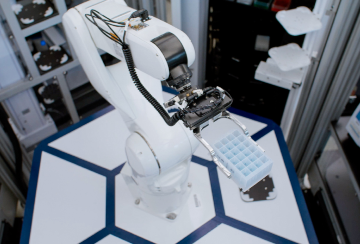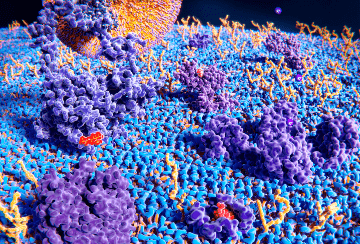Artificial intelligence (AI) and machine learning are the engines that drive many of the digital innovations people use every day. That’s how Google guesses what you’re typing into a search bar, and how social media platforms decide which posts show up in your feed. These programs provide convenience and entertainment, but as they grow more sophisticated, these tools also have the potential to impact countless people around the world.
The next great frontier for data science is analyzing patterns in patient health data in ways that empower doctors to predict and prevent serious illnesses. The latest example of this innovation is Amgen’s Crystal Bone, a new digital health algorithm under development for osteoporosis that may advance a doctor’s ability to identify a patient’s risk of bone fractures, so they can start preventative measures before a bone break happens.1
Crystal Bone’s potential to help patients at risk for osteoporosis recently caught the attention of the scientific community: Early results published as an abstract in the Journal of the Endocrine Society suggest that it is possible to use existing medical records to predict which patients are at risk for fracture over the next one- to two years. Furthermore, it may be possible to integrate Crystal Bone directly into an electronic health records system with no disruption to a clinician’s workflow and lead to improved identification of patients at very high risk for fracture.1
Digital Health: The Next Generation of Data Science
Helping people live healthier lives is exactly the sort of impact Yasmeen Almog had in mind when she joined Amgen after graduating from Princeton University with a degree in computer science engineering. “I wanted to work somewhere where I felt like I was doing good,” says Almog, now a senior associate data scientist at Amgen. “A lot of my peers went to Silicon Valley to work for companies with missions that didn’t inspire me, but I wanted to use my skills to help people in a more direct and meaningful way. Digital health was a great opportunity to do just that.”

Data scientist Yasmeen Almog led the development of Crystal Bone to use artificial intelligence and natural language processing to analyze data from electronic health records.
Almog’s first attempt at data science didn’t focus on health, but it did aim to solve a unique challenge. “I was a springboard diver in college, and a little-known fact about springboard diving is that very few people have the expertise to judge the sport,” she says. "In competitions, the coaches end up being the judges, which obviously presents a bias.”
For her senior thesis, Almog built an algorithm that used computer vision and machine learning in an attempt to remove the bias from springboard diving competitions. That sense of curiosity and a knack for engineering solutions to complex problems is what led her to Amgen’s emerging digital health team, where she led the development of Crystal Bone to use AI and natural language processing to analyze data from electronic health records.
Her goal was to build a seamless tool to help doctors to predict their patients’ risk of fracture from osteoporosis without needing to collect or submit any additional data. “Most AI in medicine right now is centered around analyzing images, like reading X-rays to spot fractures in osteoporosis patients,” says Mary Oates, MD, U.S. medical lead for Bone Health at Amgen. “Crystal Bone is the first tool I’ve seen that has the potential to plug into existing electronic health records and use diagnosis codes to help predict risk for a disease state.”
Because Crystal Bone is designed to integrate directly into existing electronic health records, it doesn’t require the transfer of protected patient data to a different system. “The algorithm and associated software will be installed and secured by the provider’s information systems team,” says Chris Andersen, Crystal Bone program director and director of Technology Strategy & Innovation in Digital Health at Amgen. “Neither Amgen nor its contractors will have access to any personal health information/patient identifiable information (PHI/PII) at any time.”
From Predictive Text to Health Predictions
The Crystal Bone algorithm was directly inspired by the same type of natural-language processing that enables predictive text on digital devices. “On your smartphone, you have these algorithms that look at the surrounding context of the language to predict what you’ll say next,” Almog says. “Crystal Bone does the same thing, but the context is the diagnosis codes from a patient’s electronic health records, and the prediction is the likelihood that they’ll experience a fracture within a certain time period.”
Andersen explains that the greatest impact of Crystal Bone may be the timeline of the predictions. “The currently available fracture risk calculators have a 10-year risk prediction window,” 2 he says, “while this algorithm has the potential to predict within a one to two-year timeframe.”1
The one- to two-year timeframe presented a significant challenge, but it was also an integral part of the project, because it would create the best tool for patients. “There are already tools out there that predict fractures on a 10-year time horizon,”2 Almog says. “We wanted to predict fractures on a shorter timeframe to demonstrate the urgency of the situation for patients at highest risk of fracture, and the result was an algorithm trained to predict a two-year future.”1
Empowering Doctors to Predict and Prevent Osteoporosis
Osteoporosis is a chronic disease that causes bones to weaken, which can lead to debilitating fractures.3 A report from the U.S. Department of Health and Human Services shows that one in two women over the age of 50 in the U.S. will break a bone due to osteoporosis in their remaining lifetime, and in the US, osteoporosis sends more women over the age of 55 to the hospital than heart attacks, strokes or breast cancer, according to a comparative study from the journal Mayo Clinical Proceedings. 4,5
“Right now, patients are at risk for fractures. The current healthcare system reacts by spending a lot of money to treat the patient after a bone breaks,” Andersen says. “We are working to shine a big light on this risk before the fracture occurs.”
“Osteoporosis is a disease state which is sorely underdiagnosed—the reality is most patients aren’t diagnosed with osteoporosis at all, let alone after they have a fracture,” Dr. Oates says.
Amgen has more than two decades of industry-leading expertise in treating osteoporosis, and now the hope is that Crystal Bone can do even more to help doctors identify fracture risk and support patients before fractures occur. "We have the deep scientific knowledge to support a tool like this because we’re a leader in bone health and osteoporosis care right now,” Dr. Oates says.
Following recent publication of the abstract in the Journal of the Endocrine Society, and manuscript publication in the Journal of Medical Internet Research, the next step is to conduct appropriate validation testing of the algorithm.
REFERENCES:
- Almog Y, Rai A, Mishra A, et al. Crystal Bone: Personalized, Short-Term Fracture Risk Prediction with Natural Language Processing Methods. JES. 2020; 4 (Suppl 1): A9-A10. OR13-07
- National Osteoporosis Foundation. FRAX Tool. https://my.nof.org/frax-tool. Accessed August 25, 2020.
- National Osteoporosis Foundation. What is Osteoporosis and What Causes It? https://nof.org/patients/what-is-osteoporosis. Accessed July 14, 2020
- U.S. Department of Health and Human Services. Bone Health and Osteoporosis: A Report of the Surgeon General. Rockville, MD: U.S. Department of Health and Human Services, Office of the Surgeon General, 2004.
- Singer A, Exuzides A, Spangler L, et al. Burden of illness for osteoporotic fractures compared with other serious diseases among postmenopausal women in the United States. Mayo Clin Proc. 2015;90(1):53-62



